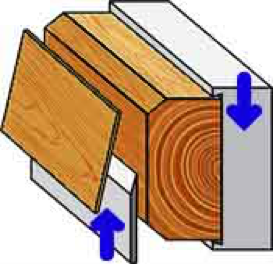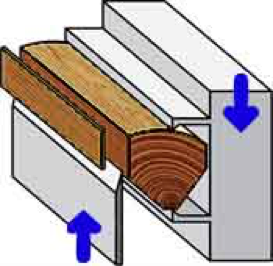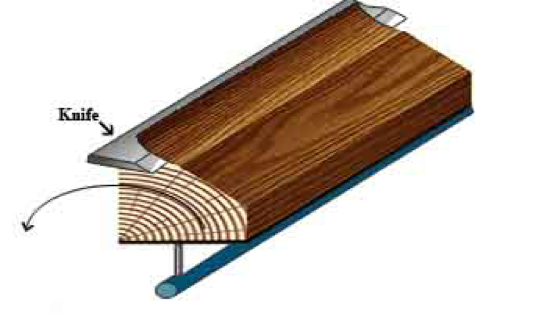Wood veneer is one of the most sought after wood products. It is essential for the slicing of wood to be impeccable to get uniformly cut veneer. If the process of obtaining veneer is not carefully dealt with, not only does it lead to poor quality f veneer, it also causes a great deal of wastage.
The species of wood, size of the log and the grain pattern are few properties of wood which are factored in before deciding the cutting methodology to get the desired product.
Some of the methodolies adopted for veneer cutting are:
Rotary Cut Veneer:

This method is mostly used for getting veneer from Birch, Maple and Oak tress. The log is turned around its axis and rotated , slicing off the veneer sheets. This methodology is comparable to a carpet roll.The resulting veneer is excepetionally wide. This cut follows the logs growth rings and hence produces a variegated grain marking.This veneer produced is the least expensive veneer type.
Crown Cut Veneer:

This is a common veneer cuttig method. The half log is positioned on the flitch table with the heart side against it. Slicing of the log is done parallel to a line through its centre.This method produces produces multicoloyred, light and unique patter. The veneers thus obtained are always uniform and hence command moderate price.Most species of wood can use this cut to get veneers.
Quarter Traditional Cut Veneer:

To achieve veneer with staright grains, this methodology is often preferred. The quarter log is mounted on aflitch table in aa way that the growth rings hit the blade at a right angle.Quartered leaves are sliced ,which are narrower and easily matched than the plain sliced ones.To get this cut, larger diameter of logs is essential. Oak is one of trees sliced for veneer using this cut.
Quarter Rift Cut Veneer:

The rotation speed of the log in this method is set by the log size, its shape and specific options of the species of wood . The desired thickness of the veneer sheets is also factored in. This cut is completed at a slide angle from the position of the quarter log resulting in a a comb or rift grain effect.
From all these methodoliges, different visual effects can be achieved. Although,the innate attributes of wood matter a lot in getting the final product, veneer making is deeply effected by the cut chosen. The beauty of working with veneer is the fact that two logs of same specie of wood can be cut in different ways, producing distinct veneers.

